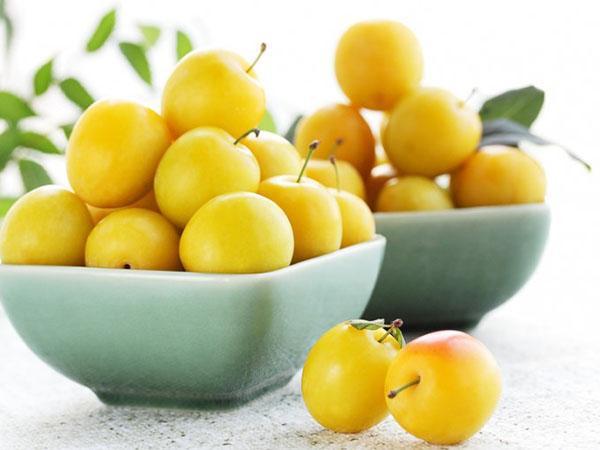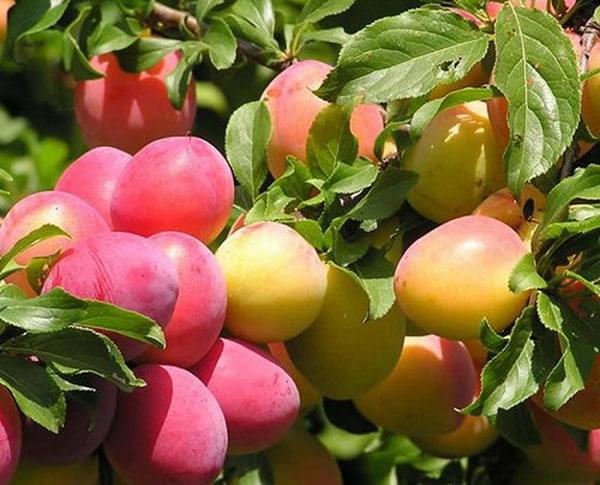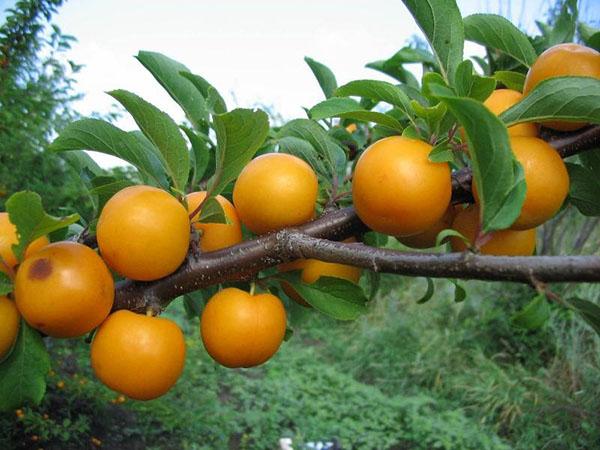The benefits of cherry plum and harm: are these fruits needed on your table
 Cherry plum is a thermophilic plant with rounded fruits that can be used for food. The benefits of cherry plum and harm depend on its use, taking into account contraindications, correct collection and storage of fruits. Cherry plum is a fruit crop that is found in the wild nature of Ukraine, the Caucasus, the Balkans and some other regions. It is cultivated in many regions of Russia and Western Europe.
Cherry plum is a thermophilic plant with rounded fruits that can be used for food. The benefits of cherry plum and harm depend on its use, taking into account contraindications, correct collection and storage of fruits. Cherry plum is a fruit crop that is found in the wild nature of Ukraine, the Caucasus, the Balkans and some other regions. It is cultivated in many regions of Russia and Western Europe.
Composition and calorie content

Why is cherry plum useful? This fruit consists of 9/10 water and is rich in the following substances:
- vitamins (PP, group B, C, E, A);
- organic acids;
- pectin;
- carotene;
- minerals (magnesium, phosphorus, iron, calcium, sodium, potassium);
- carbohydrates;
- fats;
- proteins.
There is more fiber in the skin of the fruit than in its pulp. It helps cleanse the body. Cherry plum seeds are used in the production of sorbent - activated carbon, and also serve as raw materials for the production of cosmetic oil.
The calorie content of cherry plum is about 30 Kcal, which makes it possible to use the fruit in the preparation of low-calorie diets.
What are the benefits and harms of cherry plum
 The main benefit of cherry plum is associated with its effect on the digestive tract. The fruit stimulates the intestines, removes toxins, promotes better food digestion.
The main benefit of cherry plum is associated with its effect on the digestive tract. The fruit stimulates the intestines, removes toxins, promotes better food digestion.
Other beneficial properties include:
- beneficial effect on the nervous system;
- anti-aging effect;
- improving skin condition;
- relief from coughing, viral diseases;
- choleretic action;
- soft drop in pressure;
- normalization of metabolic processes in the body;
- replenishing the lack of vitamins;
- improvement of the blood circulation process.
The beneficial qualities of cherry plum make it possible to use it for such health problems:
- infectious diseases;
- scurvy;
- nervousness;
- depressive conditions;
- excess body weight;
- migraine;
- disruption of the liver;
- sleep problems;
- lack of vitamins in the diet;
- fragility of bones;
- cardiovascular pathology;
- poor eyesight;
- weak immunity;
- migraine.
In addition to benefits, cherry plum can also cause harm. It is associated with the high amount of fiber in the fruit and the chemical composition of the product. Laxative effects are possible when consumed in large portions. For those who have a weak intestine, it is better to stop eating cherry plum.
These fruits are not recommended for such conditions:
- inflammatory processes in the digestive system;
- individual intolerance;
- tendency to bowel disorder;
- allergy to the product.
Since the fruit has a low glycemic index (25), cherry plum can be used with benefit and without harm in moderation by patients with diabetes mellitus.
Recommendations for the selection and storage of fruits
 In raw food and for storage, whole ripe fruits are used that do not have any damage: cracks, dents, mold. Intended for compote or making jam fruit may have minor flaws. The harvested fruit should be stored in a cool place.
In raw food and for storage, whole ripe fruits are used that do not have any damage: cracks, dents, mold. Intended for compote or making jam fruit may have minor flaws. The harvested fruit should be stored in a cool place.
The beneficial properties of cherry plum, if there are no contraindications, are largely related to the correct collection and storage of fruits. The pulp of the fruit should be juicy and fragrant in yellow or peach color. Reddish blotches are possible.
Use for weight loss, in the diet of children and during pregnancy
 The composition rich in useful substances allows the product to be introduced into the diet of children.Mild stimulation of intestinal motility and natural composition contribute to the use of cherry plum during pregnancy, during a cold, to enrich the diet.
The composition rich in useful substances allows the product to be introduced into the diet of children.Mild stimulation of intestinal motility and natural composition contribute to the use of cherry plum during pregnancy, during a cold, to enrich the diet.
The low calorie content of the fruit allows those who follow a diet to use it. In this case, the fruit will become an alternative to sweets and other high-calorie foods.
In addition to being eaten raw, it is used to prepare:
- jam;
- compotes;
- sauces;
- jams;
- use dried cherry plum.
Types and varieties
 There are a large number of varieties and hybrids of cherry plum - several hundred.
There are a large number of varieties and hybrids of cherry plum - several hundred.
All of them are conventionally divided into several categories depending on the following conditions:
- ripening period;
- type of crown;
- pollination method;
- conventional or hybrid;
- group membership.
In most regions of the country, frost-resistant varieties with abundant fruiting are cultivated. Popular include:
- Gold of the Scythians;
- Traveler;
- Not laughing;
- Sima;
- Huck;
- Monomakh;
- Comet;
- Chuk and others.
By selection, cherry plum hybrids are obtained that have:
- the best taste;
- easy separation of bones;
- compactness of the crown;
- frost resistance;
- abundant fruiting.
The color of the tree fruit depends on the composition. The darker one has more pectin, the yellow one has citric acid and sugar.
 Cherry plum is used in cosmetology, folk medicine and cooking. Eating fruits in moderation will strengthen the body, improve bowel function and increase resistance to adverse environmental influences.
Cherry plum is used in cosmetology, folk medicine and cooking. Eating fruits in moderation will strengthen the body, improve bowel function and increase resistance to adverse environmental influences.